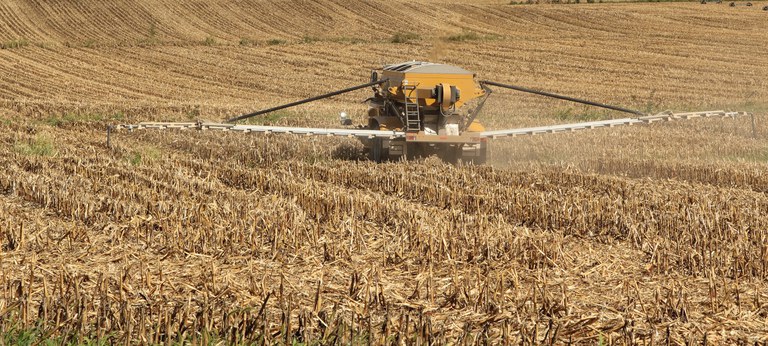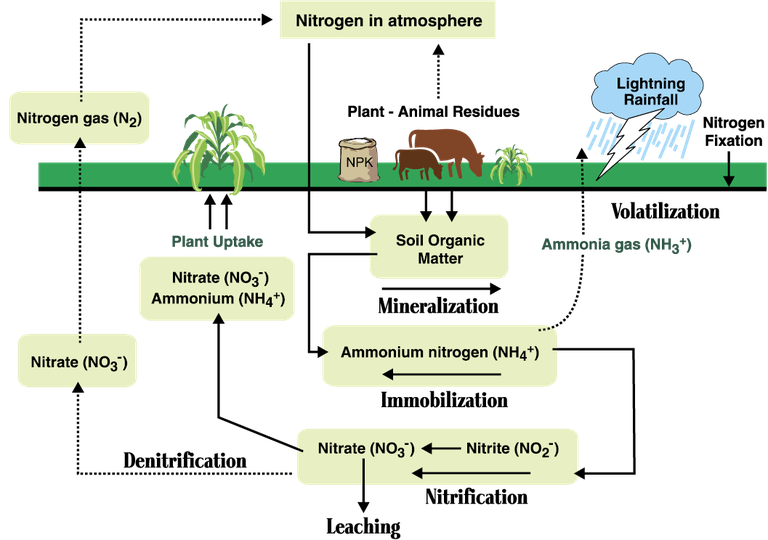what is the process that reduces nitrate (no3-) to gaseous nitrogen (n2) called?
Manure and commercial fertilizers contain nutrients essential for constitute growth. Nitrogen, phosphorus and potassium are the most critical of these nutrients. This publication outlines some basic information nearly nitrogen and its interaction in the environment.
Availability: Web only

Nitrogen (N) is a vital chemical element institute in all living things. Crops require nitrogen in relatively large amounts, making it the nutrient most oftentimes deficient in ingather product.
Managing nitrogen inputs to achieve a residue between profitable crop production and minimizing nitrogen loss to the environment should be every producer's goal. The behavior of nitrogen in the soil system is complex, still understanding the basic processes tin can lead to a more efficient nitrogen management program.
Nitrogen is changing its chemic form continually and moving from plants through animals, soil, h2o and the atmosphere. This movement and transformation of nitrogen in the environs is known as the "nitrogen bicycle" (Figure 1). Critical processes in the nitrogen bicycle affecting manure handling and institute growth include the following:

Figure 1. The nitrogen cycle. (Source: Livestock and Poultry Environmental Stewardship Curriculum)
■ Mineralization — the conversion of organic nitrogen in soil organic matter, ingather residues and manure to inorganic nitrogen (ammonia and ammonium). In this process, soil microorganisms intermission down organic material and release ammonium (NH4+) nitrogen. Germination of NH4+ increases as microbial activity increases, and microbial growth is directly related to soil temperature and water content.
■ Nitrification — the conversion of ammonium through nitrite (NO2–) to nitrate (NO3–). Nitrification is a biological procedure that specific species of bacteria mediate. Information technology proceeds rapidly in warm, moist, well-aerated soils. Nitrification slows when soil temperatures drop below 50 F. Ammonium-forming fertilizers should not exist fall-applied until soil temperatures are beneath fifty F.
■ Immobilization — the conversion of inorganic nitrogen to organic nitrogen. Microorganisms that decompose loftier-carbon, low-nitrogen residues, such as corn stalks or small-grain harbinger, need more nitrogen to interruption down the material than is present in the rest. Immobilization occurs when the growing microbes use nitrate and/or ammonium nowadays in the soil to build proteins. A temporary reduction in the amount of found-bachelor nitrogen occurs post-obit immobilization (tie-upward) of soil nitrogen.
■ Volatilization — the release of ammonia into the atmosphere. Significant losses from some surface-applied nitrogen sources tin can occur through the procedure of volatilization. In this process, nitrogen is lost as ammonia (NH3+) gas. Ammonia is an intermediate form of nitrogen during the procedure in which urea is transformed to NH4+. Volatilization rates are greatest when the soil pH is higher than seven.3 and the air temperature is high.
■ Denitrification — the process by which bacteria convert nitrate (NO3–) to nitrogen gas (N2), which is lost to the atmosphere. Denitrifying bacteria use NO3– instead of oxygen in their metabolic processes when the soil temper lacks oxygen. Denitrification occurs in waterlogged soil with ample organic matter to provide energy for leaner. For these reasons, denitrification by and large is limited to topsoil. Denitrification can go along chop-chop when soils are warm and saturated for 2 or three days.
■ Leaching — the downward movement of nitrate through the soil profile with soil h2o. In contrast to the biological transformations previously described, loss of nitrate past leaching is a concrete event due to water percolation through the soil. Nitrate is soluble and moves with backlog soil water below the root zone. Nitrate that moves below the root zone has the potential to enter groundwater or surface water through tile drainage systems. The federal standard for the amount of nitrate-nitrogen allowed in drinking water is 10 parts per million.
To summarize these processes, keep in listen that nitrogen is lost from the plant/soil surround through the processes of volatilization, denitrification and leaching. Of course, harvesting crop products also removes nitrogen.
Plants' Nitrogen Uptake
Animal manures and other organic wastes can be important sources of nitrogen for plant growth. Although nitrogen tin can be added to soil in organic or inorganic forms, plants have upwards only inorganic nitrogen (that is, NO3– and NH4+). The organic nitrogen components of any fertilizer, including manure, must exist mineralized to inorganic forms earlier they are available to plants. Commercial Northward fertilizers, legumes, manures and crop nitrification can result in less nitrogen loss and more plant uptake.
Nitrogen Interaction With Soil
Soil consists of many negatively charged mineral and organic particles. A measure of the full negative charge in soil is called its cation exchange capacity, or CEC. Most soils take enough exchange capacity to blot and concur all positively charged particles or nutrients in soils. While the soils exchange chapters can hold ammonium ions, nitrate is a negatively charged nutrient and the negatively charged soil particles generally repel it, causing it to remain in the soil solution.
H2o moving through soil will leave most nutrients "stuck" on the soil cation exchange sites. Nitrate is extremely soluble in water, so h2o picks it upward and carries information technology forth while moving through the soil.
Coarse-textured soils have large pore space, resulting in lower water holding capacity. Therefore, these soils have a higher potential to lose nitrate via leaching, when compared with fine-textured soils. Some sandy soils, for instance, may retain only ½ inch of water per human foot of soil, while some silt loam or clay loam soils may retain up to 2 inches of water per foot. Even so, nitrate can be leached from any soil if excess rainfall or irrigation saturates the soil and causes water to move through the root zone.
Ammonium nitrogen has properties that are of practical importance for nitrogen management. Ammonium has a positive accuse, and the negatively charged soil and soil organic thing attract or hold it. This means that NH4+ does not movement downwardly in soils. However, NH4+ that plants exercise not take upwards is subject field to change (conversion to NO3–) by the biological transformation occurring within days of NH4+ awarding to the soil organization.
Inhibiting the conversion of NH4+ to NO3–, or nitrification, can effect in less nitrogen loss and more than plant uptake. Nonetheless, preventing nitrification totally is not possible. Nitrification inhibitors are available commercially. These inhibitors are added to nitrogen fertilizers, including manure, and they work by inhibiting the growth of the bacteria that crusade nitrification.
No fashion is available to totally forestall the loss of nitrogen to the atmosphere via volatilization or by the movement of some NO3– to h2o supplies, but sound management practices can go along losses within acceptable limits. These practices can include proper application timing, placement and incorporation, equally well as appropriate storage and handling of manure or commercial fertilizers.
For additional information on water quality, see these other NDSU Extension Service publications and resources:
■ "Ecology Implications of Excess Fertilizer and Manure on H2o Quality"
■ "Phosphorus Behavior in the Surround"
■ "North Dakota Fertilizer Recommendation Tables and Equations"
■ North Dakota Corn Nitrogen Computer
This publication was authored by Ron Wiederholt, NDSU Extension Service southeast district director, and Bridget Johnson, former NDSU Extension area nutrient management specialist.
(Revised Oct 2017)

Source: https://www.ag.ndsu.edu/publications/environment-natural-resources/nitrogen-behavior-in-the-environment
0 Response to "what is the process that reduces nitrate (no3-) to gaseous nitrogen (n2) called?"
Post a Comment